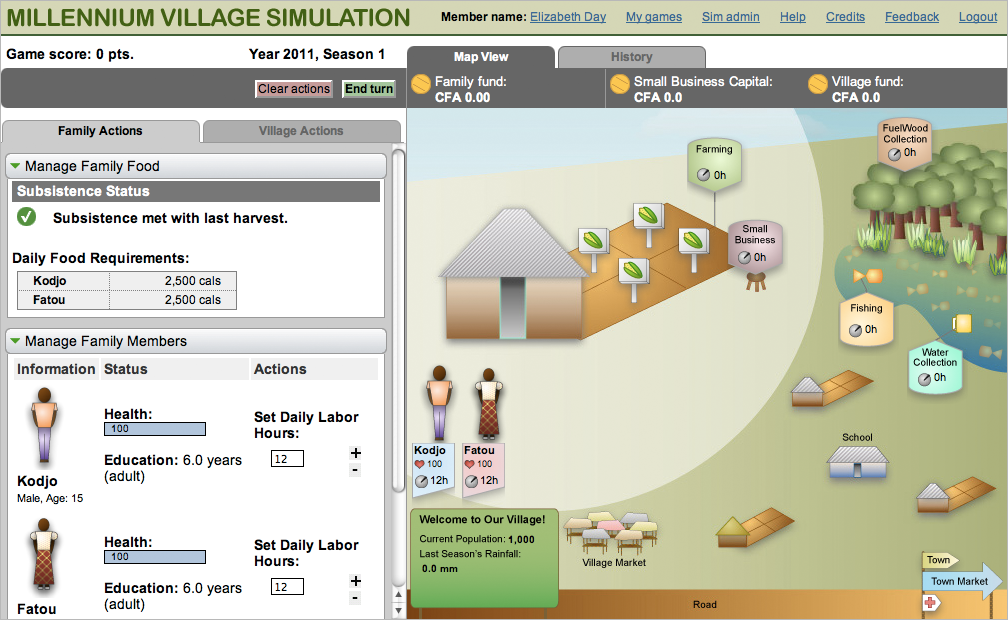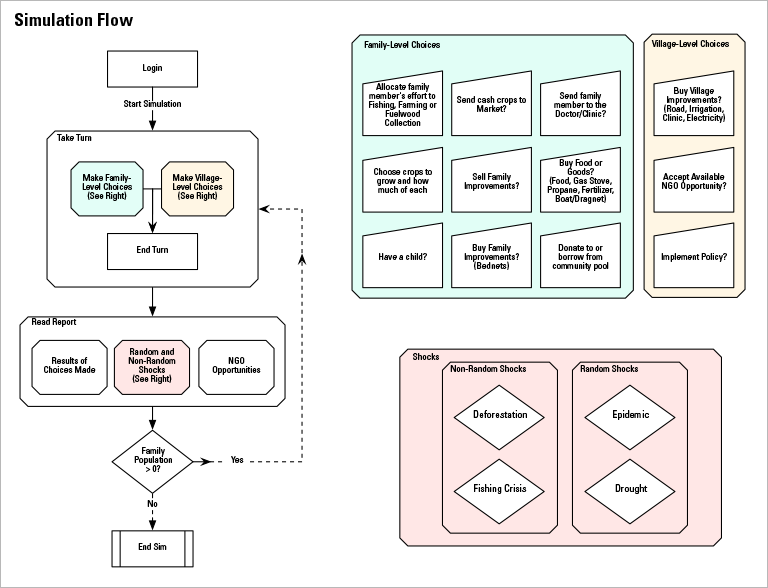Millennium Village Simulation
Serious Game as Sustainability Teaching Tool for the Earth Institute
Project Dates: 2008
Partners: Columbia University Center for New Media Teaching & Learning (CCNMTL), Jeffrey Sachs, The Earth Institute, Columbia School of International and Public Affairs (SIPA)
My Roles: Strategy, Information Architecture, UX Design, UI Design, Icon Design, Illustration, HTML, CSS
Africa has the greatest proportion of people living in extreme poverty — more than 32 percent, or roughly 300 million people, living on less than $1 a day.
The factors contributing to this situation — including environmental, epidemiological and geographical challenges, among others — are multitudinous, extremely complex and systemic. Professionals wishing to help rural communities lift themselves out of extreme poverty must, therefore, possess an ever growing ability to distance themselves from their traditional training and specialization in order to see the bigger picture of how all of the issues — and possible solutions — are interrelated.
The Millennium Village Simulation is a serious game which plays out the economics of survival for one family and their village in sub-Saharan Africa.
By making decisions regarding both village priorities and the family’s allocation of time and financial resources, players develop a greater understanding of the manifold disciplines — such as agronomy, nutrition, economics, epidemiology, public health and development management — that constitute sustainable development and how those disciplines interact with each other in “real world” scenarios.
Users can experiment with different simulation configurations to see the cascading effects of subsidies and other potential interventions on systemic models such as agricultural, logistical growth, climatological, disease, and subsistence/health, all of which are introduced through the environment and with explanations and tutorials about the models and their role in the simulation. Developed with Jeffrey Sachs, director of the Earth Institute, the Millennium Village Simulation is freely available to students, professional sustainable development practitioners and the general public.
Family View
In the face of realistic challenges like extreme poverty, disease, and environmental variability, players' goal is to help a new couple survive, prosper and grow their family over a fifty-year period. Each turn represents six months in the couple's life — for each round, players must allocate available financial resources and time across farming needs, health needs and capital expenditures and investments, as well as decide what to plant, whether to try for children (if health is sufficient), and even how to allocate (or sell) the food from the previous season's harvest.
In order to make the simulation rich, we worked diligently with faculty from SIPA to add as many realistic layers as possible, including choices about whether to send children to school or keep them home to work; whether to accept NGO subsidies; and whether to plant food to eat or food to sell (meaning that the family would depend on income from sales to buy food). In some cases while playing the game, it becomes very clear that certain choices, such as not treating illness due to lack of resources — or feeding one family member at the expense of another — will likely result in death for one or more family members.
Village View
In the Village view, players make choices on behalf of the community, deciding whether to levy taxes in order to save for shared resources; implement limits on wood collection or fishing to protect shared resources, etc. We split the two views both because it made the different required choices clearer, and because it drove home the delicate balance between the immediate needs of a single family and the drive for sustainability within the larger community.
In contrast to other projects I have worked on, this project was notable in its lack of direct design involvement with the communities represented. It was very much a product of the Earth Institute, wholly representing the beliefs of Jeffrey Sachs and the structure of the Millennium Villages project.
In play testing the game, one element that surprised the design team was the emergence of "power players." These players became obsessed with finding ways to "game the system," effectively getting around the basic lessons in order to score insanely high point totals and stay at the top of the class leader board. While this was not desired behavior from the stakeholders' perspective, these "power players" actually learned more than their peers, developing a deep and powerful understanding of the way the levers in the virtual system interacted with one another. They became instrumental in developing the second iteration of the project.
Process Diagram
This diagram illustrates the turn-to-turn flow as the Simulation is played. With each turn, players make choices on behalf of the family and then the village. Once their choices are submitted, players are shown a report in which they can see the outcomes of theses decisions, which are also affected by algorithmically applied circumstances such as drought or epidemic. Outcomes include farming yields; the health (or sickness or death) of each family member; family and village financial health; and the state of the village forest and fishery. As the game progresses, players may also be offered opportunities for investment or development. The simulation continues as long as the family has at least one living member.




